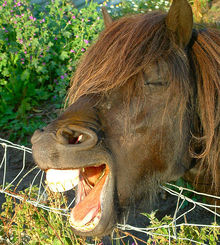Newsdate: Friday, March 24, 2023 - 10:00 am
Location: GILROY, California
Development of teeth in foals and young horses follows a definite pattern making it relatively easy to determine the age of the foal or horse by the state of his teeth and their growth. Foals begin to acquire teeth during the first week of life. The first to appear are the central incisors, with two in the upper jaw and two in the lower jaw.

Foal appearing to laugh with wide-open mouth.
As horses grow older, changes take place not only in the teeth, but also in the jaws and mouth structure so an experienced horse person may accurately determine a horse's age looking carefully in the horse's mouth.
© 2016 by Emma Holmwood New window.
Next, three premolars erupt at about two weeks of age with the second incisors appearing at around one month of age and the third incisors at six to nine months of age.
Foals and deciduous (temporary or milk) teeth
At approximately nine months of age, a foal will have a complete set of 24 deciduous teeth.
Permanent teeth arrive
The first permanent molars appear at ages nine to twelve months and the second molars erupt at two years. When the young horse is 2 1/2 years, the adult incisors appear and the first and second premolars appear. The first premolars, also known as wolf teeth, are found only in the upper jaw and are small and needle-like.
When the horse is 3 years old, the third premolars usually erupt, although the lower premolars may come through six months earlier. At 3 1/2 years, the lateral incisors and third molars are present.
At 4 1/2 years the horse has its corner incisors, fourth premolars and canine teeth. The canine teeth are usually present in a male horse, but absent or rudimentary in the mare.
By the time the horse is 5 years old, it has a complete set of 40 to 42 permanent teeth.
Aging horses 5 to 30 years
As horses grow older, changes take place not only in the teeth, but also in the jaws and mouth structure. An experienced horse person who has looked in the mouths of many horses may become very adept at accurately determining the horse's age by what is seen in the mouth of the horse.

Horse laughing and showing teeth
As horses grow older, changes take place in their teeth, jaws and mouth structure.
As horses age, the dental cups in the incisor teeth gradually disappear and the teeth become triangular.
By age 6, the lower central incisors become worn smooth with shallow cups in the laterals.
At 7 years of age, the lower lateral incisors are also worn smooth and the central and lateral incisors assume a more oval appearance.
The wear on the horse's teeth may be affected by diet, natural abnormalities, and certainly by cribbing if the horse is a "cribber.
By age 8, the lower corner incisors are worn smooth.
At 9 years, the upper central incisors are smooth with shallow cups in the laterals.
At 10 years, the upper lateral incisors are worn smooth and the central and lateral incisors appear more oval.
At 11 years, the cups of all incisors are worn smooth.
At 15 years, the lower incisors appear shorten than the uppers when seen from the front and all teeth show a distinct dark round dental star in their centers.
At 21 years of age, the angle of the jaw is distinctly oblique and considerable space has developed between the teeth. The lower incisors are often worn nearly to the gum.

Equine teeth provide a lifetime of service
Adult horse teeth grow continuously and, if properly cared for, last for 30+ years.
As aging progresses, all teeth become more worn and spaces between teeth tend to grow.
In older horses, the Galvayne's groove, which is a groove on the surface of the tooth that appears in the two upper corner incisors only at the gum line at 10 years of age can also be used as a key to the horse's age.
This groove works its way downward as the tooth begins to wear. At 15 years, the line of the groove is halfway down the tooth.
At 20 years, the line is present along the full length of the tooth.
The groove then begins to recede from the gum and at 25 years is present in the lower half of the tooth and by age 30, the groove has completely disappeared.
Also as the horse advances in age, the incisors begin to protrude against the lips creating a jaw and tooth angle that becomes more oblique with each passing year. In addition, the gums shrink or recede, causing the teeth to appear longer and more exposed. As the saying goes, the older horse is "getting long in the tooth."
Consider this
Authorities often say that after eight years of age, a horse's age cannot be definitely determined by the condition of its teeth. Dishonest dealers have been known to attempt to change the appearance of a horse's teeth to reflect a younger age, but usually other marks of age reveal the phony appearance of the teeth.
